Keep on blogging and eventually, you’ll create a river of leads. They’ll flow in all day every day. You’ll rank, convert and create demand, just as long as you keep blogging.
That’s what they say. Blog enough and you’ll eventually win.
But it doesn’t seem to work that way. Some content programs achieve results much sooner, while others never get there. So what’s the difference? Why are some content strategies so successful while others are not?
The myth of B2B content marketing
That idea, blog and grow rich, fails because it misses the key connection between content and traffic. Here’s the myth: visitors click from blog posts to service pages and then become leads.
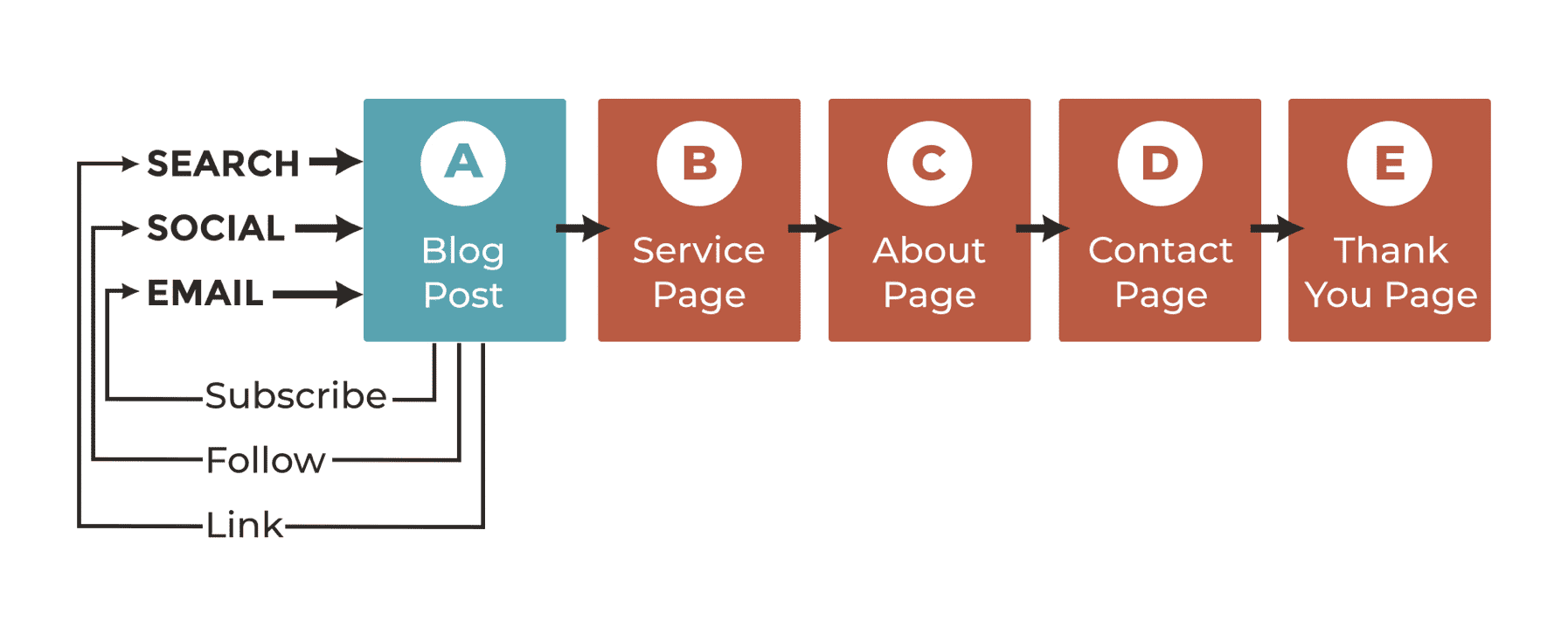
This is actually very rare for B2B service companies. When we look at the lead generation conversion rates for visitors who start their visit on a blog post, it’s abysmal. Usually just a fraction of one percent.
Why so low? Because these visitors have information-intent, not commercial-intent. It would be nice if a blog reader suddenly realized they need your business services, but it doesn’t happen a whole lot. It’s not why they’re visiting.
Blog content serves another key purpose. That content is critical because of its indirect benefits. Blogs help the service pages rank by being link-worthy. Here’s the connection:
- No content? No one will link to you.
- No links? You’ll have low Domain Authority.
- Low Domain Authority? The service pages will never rank for those competitive commercial-intent phrases.
When a blog post attracts a link, it makes every page on the site more authoritative, more likely to rank. That’s how links and authority work.

The primary goal of the B2B content strategy is this: get the service pages to rank for commercial-intent phrases. The money phrases.
Every B2B content strategist knows there are two kinds of visitors, those who just want info and those who may need your services. And the commercial-intent visitors are far more likely to convert into leads. They are pre-qualified.

Service pages are definitely not link-worthy. Ever link to someone’s service page? Probably not. A website without a blog is an online brochure, one with very low domain authority and rankings.
With a few quick segments in GA4, you can see the conversion rates for the two types of visitors for this website.
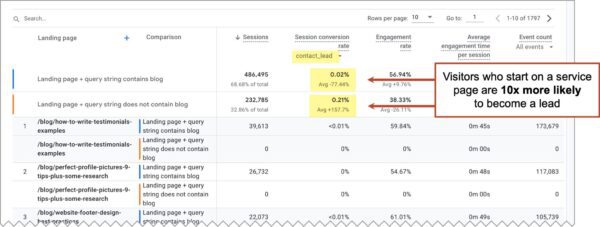
It’s the visitors who land on our service pages that drive demand. We won’t be successful until we get qualified visitors to those pages. And to get those pages to rank, we need links and to get links, we need…
An SEO-driven B2B content strategy
Here is an example of a 7-part content strategy framework for B2B lead generation built for SEO. We’ll use a fictional coffee delivery service, Speedy Bean. But these concepts apply to any B2B business and most B2C marketers as well. This is for anyone in any business focused on SEO and lead generation.
1. The Core: The search optimized, conversion optimized sales page
At the center of all digital marketing is the sales page. It is built to attract and convert qualified visitors, the people who need our help and our coffee. It’s optimized in both ways:
- Optimized to rank (SEO)
It targets a commercial-intent keyphrase for which it has a realistic chance of eventually ranking, based on the Domain Authority of our site. It indicates relevance for that phrase using all the usual SEO best practices. - Optimized to convert (CRO)
It answers all of the visitors most likely questions. It supports those answers with evidence. It includes calls to action and leverages human psychology wherever possible, using the usual conversion optimization best practices.
Barry Feldman once said “Your website is the mousetrap. Your content is the cheese.” So our first job is to build the best possible mousetrap (our search/conversion optimized sales pages) before we start creating cheese (content creation).
For our little coffee company, this page about our coffee delivery service.
Optimize your sales page to rank
We’d like to rank for “office coffee delivery” but before we target that phrase, let’s check the competition. For this, I’ll use Moz, but other SEO tools would work as well. I put our domain into the Moz Link Explorer…

Our Domain Authority is 16. So we should target phrases that are in that general range of difficulty. We are unlikely to rank if all of the other high ranking sites for a given phrase have more authority than we do.
Now let’s check the difficulty for the phrase “office coffee delivery.” I put the phrase into the Moz Keyword Explorer…
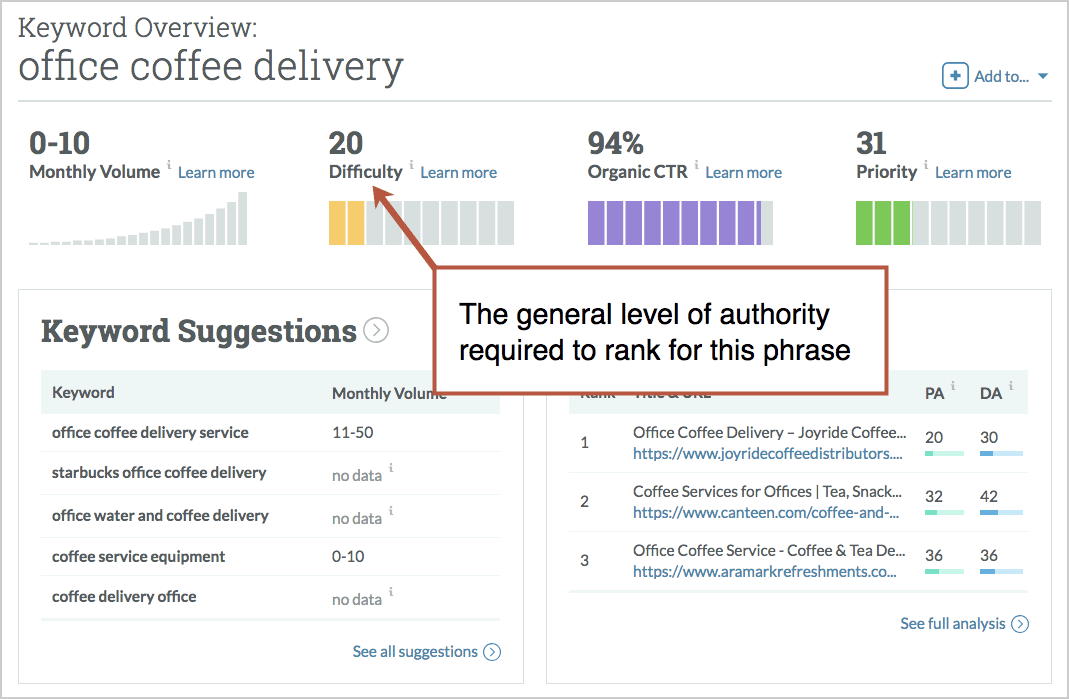
It looks like it’s a bit outside our range. To have a realistic chance of ranking for this phrase, we’ll need to build a content strategy designed to attract links to our site and increase our authority. That’s our plan! Keep reading and pay close attention to points 3, 6 and 7.
Now optimize your sales page to convert
If the conversion rate of this page is zero percent, it doesn’t matter how much traffic we generate or how good we are at content. We’ll never generate a lead.
Conversion optimization has its own framework: answer your visitors’ top questions, address their main objections, support our messages with evidence and add clear, specific calls to action. Learn how to convert your visitors here.
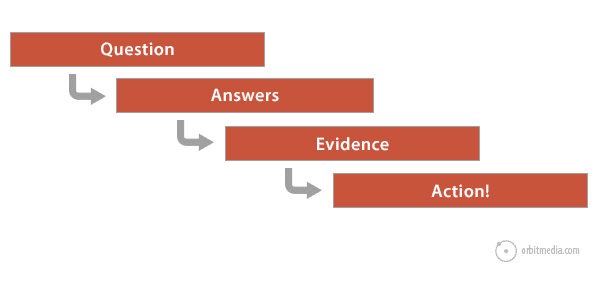
Even a little uncertainty will kill conversions. This is why web design and conversion copy is so critical. Let us know if you need help with yours.
Step 1 takeaway: Our content strategy begins with a well-optimized set of services pages, optimized to rank and targeting a phrase that is (eventually) within reach. And it is optimized to convert those visitors into leads.
2. The Mission: The foundation of our content strategy
Next, we lay the cornerstone of our content marketing: the content mission statement. It declares three simple things:
- The target audience
- The topics to be published
- The benefits of the content to that audience
Simple, right? It’s a fun exercise that I’ve done with dozens of clients. For our office coffee delivery service, I’ve decided that the content will target a specific audience, but cover a wide range of topics and have a light tone.
Here is the content marketing mission of Speedy Bean’s content (blog, emails, social posts, etc.):
Where office managers find fun tips for the workplace to build happier more productive teams.
You can see how it follows a basic template: audience + topics + benefit. You can find more examples and ideas for content mission statements here.
Documenting this mission is such an obvious first step for any content strategy that everyone does it right? Nope!
According to the B2B Content Marketing Survey, only 39% of B2B content programs have a documented content strategy. Those that do are twice as likely to report success in their content marketing.

It’s no surprise that a documented mission correlates with success. Once you’ve documented your mission, you’ve basically written your calls to action for your content.

Step 2 takeaway: Our content strategy framework begins with a documented content marketing mission.
3. Publish Research: The pillar of the content program
Next, we need to beat every content program in our industry by being more relevant, useful and original. That sounds hard, but there’s a trick: conduct and publish original research.
Original research is an all-powerful format for content for one simple reason. It makes your website the primary source of new data. It’s the most link-worthy content you could possibly create.
Just a few paragraphs below, I linked to a piece of original research. Why? Because it supports this article. And mentioning the research without citing it with a link would have been improper.
Credible content is supported with research. And when you’re the brand that creates the research, you’re helping others make their case when they cover the topic. They reward you for the favor with a link.
Here’s my idea for original research for our office coffee delivery company:
What are the office perks offered by the top workplaces in the world?
To conduct this study, I’ll need to find a list of top workplaces. That’s very easy. Next, I’ll need to reach out to office managers and HR folks at each of these companies and do a quick phone interview. That’ll take some time.
Original research is hard work. In my experience, it often takes 10x effort. But the results are generally 100x that of a typical article.
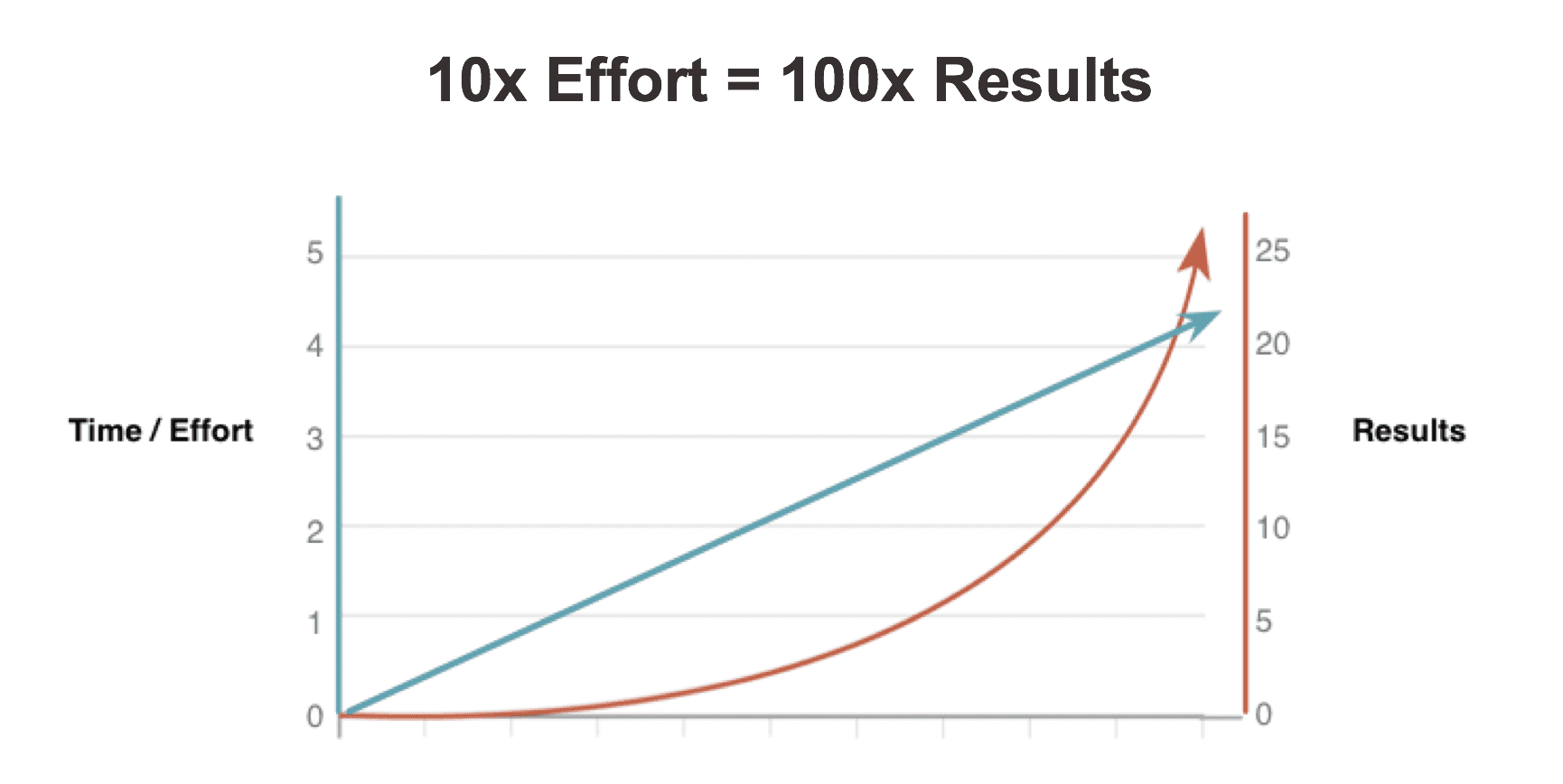
If you have access to an SEO tool, enter any domain and see which of their pages has been linked to the most. If they’ve ever published research, you’ll likely see it at the top of the report.
If you’ve ever published research, look at the links report in Google Search Console. You’ll likely see that the original research is there at the top of the report.
According to our annual blogger survey, 47% of bloggers have published original research in the last 12 months (our friends at Mantis Research asked companies, not bloggers, and found a higher percentage).

Step 3 takeaway: Our content strategy is anchored with high-value original research.
4. Write for current prospects
The best source for content ideas is the audience themselves. When you talk to prospects and customers, you learn their cares, hopes and worries. You find out what questions they have. It’s the job of your content to answer their questions.
Two amazing things happen when you write content that answers their specific questions.
- You can send the article to companies that are currently in your pipeline, keeping those conversations going
- All sales associates are unified in their messaging, they can send the link to future prospects who have that same question
This is why the best content marketers work closely with sales teams. They ride shotgun to meetings. They jump into sales calls. They listen for questions and answers, then publish accordingly.
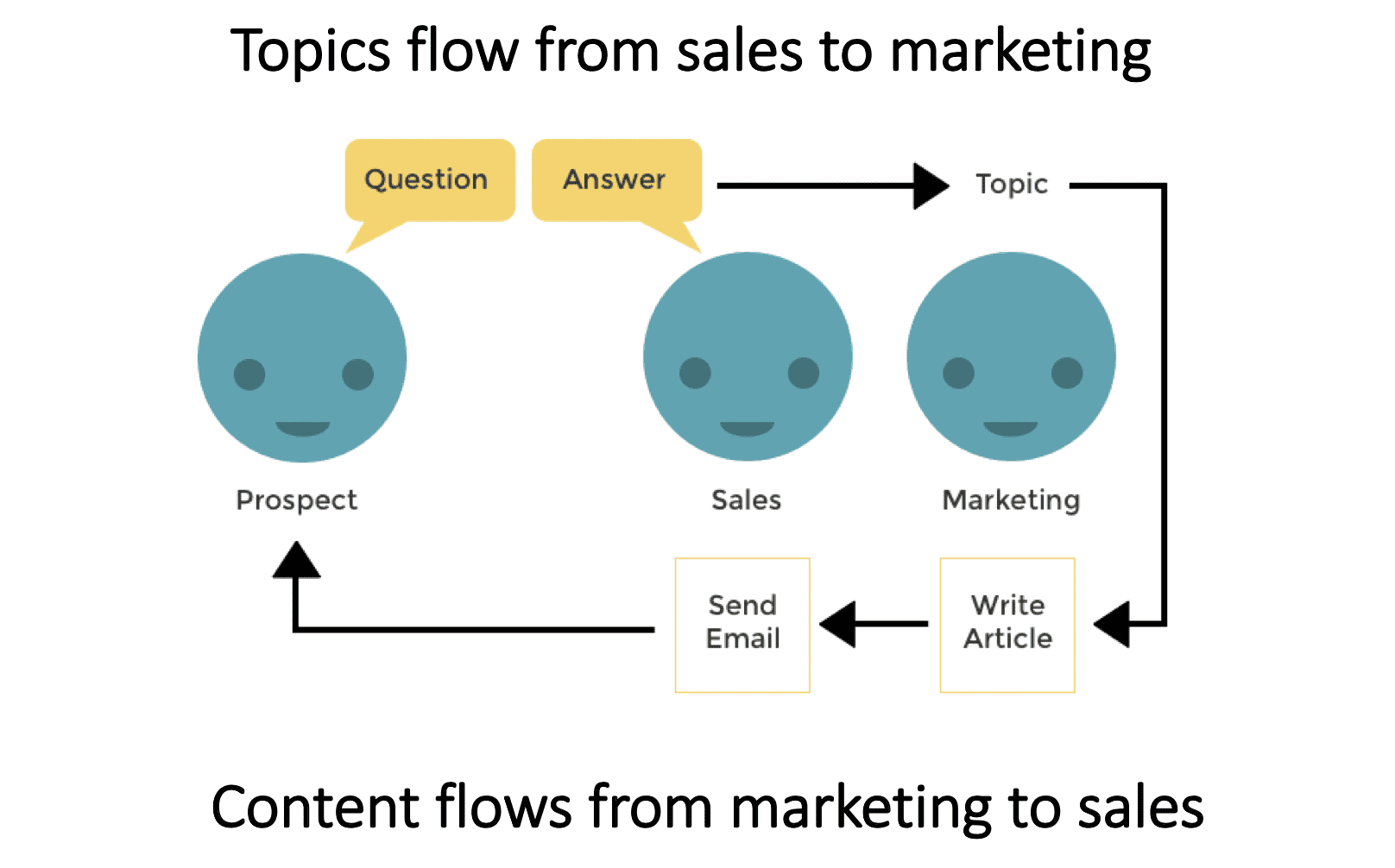
So I listened in on some sales calls at our hypothetical coffee delivery company and discovered that some prospects don’t appreciate the life-changing benefits of whole bean coffee, ground fresh each morning.
Now I know exactly what to publish and share with the sales team. They can pass it along to current and future prospects forever after. After all, the prospects in our sales funnel are our most important audience!

Step 4 takeaway: Our content strategy includes topics and articles that are commonly asked by our prospects.
5. Using visuals
Every successful content strategy I’ve seen has a foundation of well-written articles (text). Every successful content strategy also uses visual formats regularly (images and video).
The majority of blog posts now include multiple images and nearly one in four bloggers regularly create video (source). We need to go beyond text and create more visual versions of our most important content.
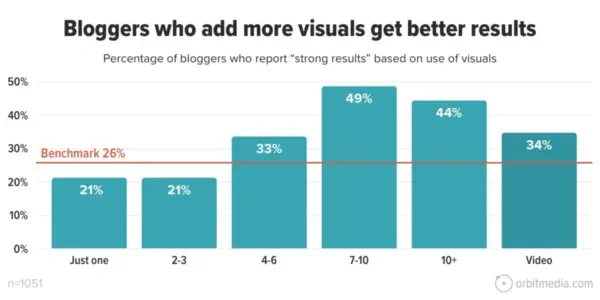

Assuming our article about the amazing benefits of whole bean coffee was successful, it’s a candidate for repurposing as a visual. Here’s what it might look like as an infographic.

Step 5 takeaway: Our content strategy includes consistent use of visual formats, including infographics and video.
6. Collaborate with influencers
Everything is better with friends. Bloggers who collaborate with influencers get better results.

Collaborating with influencers is good for your content strategy in so many ways. Here are five quick ones:
- Improve the quality of your content (assuming they’re experts)
- Increased traffic from social media (assuming they share)
- Greater credibility (assuming they are reputable and support your message)
- Good for your personal network (assuming you keep in touch)
- More fun! (assuming you like people)
And it doesn’t have to be expensive or time-consuming. In fact, “organic influencer marketing” (which is really just collaborative content marketing) is free and can save you time. Here are five quick ways to do it:
- Ask a relevant, credible source for a contributor quote
- Send a few relevant questions to a small set of relevant sources (round up)
- Find one very relevant influencer and email them a series of questions (interview)
- Invite a relevant content creator to write an article for your site (host a guest post)
- Offer to write an article for a relevant blog (pitch a guest post) …More on this idea in just a minute.
Collaborating with content creators is powerful, partly because it supports our long term goal of building our authority (and getting that sales page to rank). The idea is partly to make our brand and our content more visible to people who create content. Because people who make content make links.
We aren’t actively trying to get these journalists, bloggers and editors to link to you. But we also aren’t naive. We’re hoping that future collaborations lead to links to your content on your site.
All good things (including search rankings) are built on relationships.

So everyone is collaborating with influencers, right? Nope! Only 18% of B2B brands have ongoing influencer marketing campaigns.

Source: Traackr, Altimeter Group
 |
“When an influencer contributes to an article, show them in their best light. Highlight some of the person’s achievements and link to their website. This will do more than give your article increased credibility; you are also helping that individual build their personal brand.” – Kristen McCabe, Content Strategist, CommonMind |
Step 6 takeaway: Our content strategy includes ongoing collaboration with influencers.
7. PR focus: Write for other websites
This tactic directly leads to links and authority. Publishing original research and building relationships with content creators might lead to links, but when you write for someone’s website, you’re almost certainly going to create a link back to your site, in the author bio if not in the article itself.
Especially for younger content programs, earlier in the process of building an audience, guest blogging and digital PR are so important.
Imagine two bloggers. They each write eight articles. Blogger A publishes those articles on their own site. Blogger B pitches four of those articles to other websites. Blogger B also invites four contributors to write for her blog.
Look at the difference. Blogger B has more links (great for search) and more friends (great for social).
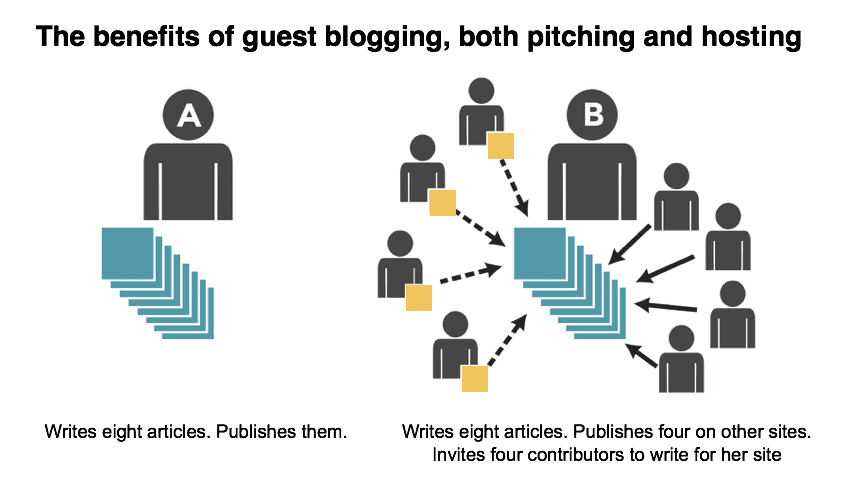
So if guest blogging is so effective, everyone does it, right? Nope! Our latest research shows that only 60% of bloggers ever write and pitch guest posts.

Step 7 takeaway: Our content strategy is PR focused and involves pitching and publishing guest posts.
Connecting the dots
Let’s step back and see how each all this content fits together. This chart shows how all of the content connects. Below we’ll list a quick description of each piece.

-
- The service page: Optimized for “office coffee delivery service” and filled with answers to sales questions, testimonials and CTAs.
- Original research: Survey of “Office Perks of the Top 50 Workplaces” includes charts and data, along with contributor quotes from influencers.
- The content upgrade: A gated Ebook “Complete Guide to Top Office Perks” is a more detailed version of the survey, available to anyone who subscribes.
- How-to article: “How to retain your top employees” is keyphrase-focused and optimized to rank. It includes charts from the research and quotes from influencers.
- How-to guest post: “How to lose a top performer in 10 days” is a fun spin on the same article, pitched as a guest post to an HR blog. It’s the evil twin of the how-to article.
- Infographic: “Top Perks at Top Offices” is a visual version of the research featuring charts, stats and analysis in a short article.
- Guest post / Infographic: Pitching the infographic along with a short, original article to an HR blog is an effective way to get a guest post accepted.
- Influencer interview: “What employees really want” is an emailed interview with a relevant influencer about employee happiness, retention and the research on office perks.
- Contribution / Interview: “Office Perks Expert Shares New Research on Top Workplaces” Pitch yourself to an employee benefit or HR podcast! Discuss the research and the show notes will link back to your survey.
- Blog post one: “5 Workplace Secrets: An inside look Into the top offices”
- Blog post two: “Coffee, Tea or Beer? What are they drinking at the top companies in the country?”
- Blog post three: “The Dirt on Dishes: What’s wrong with office kitchens”
This goes beyond a typical content marketing plan, beyond just blogging. It’s a content marketing framework built specifically to build authority and leads, possible for any B2B brand…
…but only 1% of content strategies will do this
Most content strategies do the usual (blogs, newsletters, an occasional ebook) while others use less common tactics (research, influencer collaboration, and video).
And a very small percentage of content strategies (about 1%) combine these tactics to build powerful platforms for high rankings, huge traffic and loads of conversions.
Let’s do the math. As we’ve seen…
- 39% of content programs have a documented content mission
- 25% are anchored in original research
- 18% have ongoing influencer marketing campaigns
- 60% are PR focused

Multiple those percentages and you get 1%. That is, roughly 1 in every 100 content strategies combine all of these tactics. Certainly, it’s rare.
How long will this take?
“Keep on blogging and eventually, you’ll create a river of leads.” We started by saying that this isn’t true. But this is about content strategy, not just blogging.
We have a mission-driven, research anchored, influencer powered, PR-focused content strategy framework.
And with this framework, I am 100% confident of success. I have no doubts whatsoever. But how long will it take?
Assuming that each quarter, we publish a hub of content as shown above. This becomes our content calendar. And each round leads to just 5-10 links, within nine months we should have a high enough domain authority for our sales page to rank for “office coffee delivery.”

Within a year, we’ll have a river of qualified leads flowing in through our contact form.




